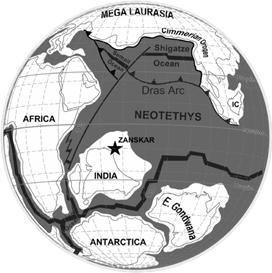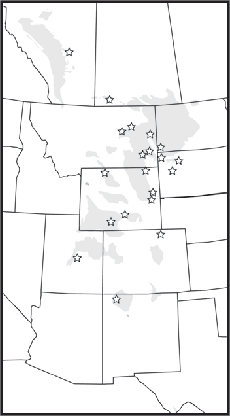
 |
Tectonic plates and Cretaceous geography |
Mesozoic geography was dynamic on global and regional scales and likely influenced the evolution of major clades, such as mammals. Yet, our view of this influence is limited by the spatiotemporal distribution of fossil localities.
Gondwana
Mesozoic fossil localities are mostly known from northern landmasses. However, recent discoveries from southern landmasses hint at another view of early mammal evolution. This fits paleogeographic reconstructions, which show isolation of northern and southern landmasses via the breakup of Pangaea. Their continental biotas consequently evolved independently. Through fieldwork in Africa and India, we are adding to this view of mammal evolution on Gondwana.
Depositional basins of North America (shaded) and well-sampled latest Cretaceous mammal localities (stars). |
North America
Within North America, latest Cretaceous fossil localities are mostly known from the northern Western Interior (e.g., Alberta, Montana). These localities mostly sample faunas from coastal lowland paleoenvironments along the Western Interior Seaway. Sparse fossil data from farther south along this coastal lowland transect (e.g., Colorado, New Mexico) hint at latitudinal differentiation of vertebrate faunas during this interval (Lehman 1987, Weil 1999). Even sparser fossil data south and west of the proto-Rockies (e.g., Baja California) suggest that these areas may have been a source of immigrants for the Paleocene radiation of mammals in the Western Interior (Weil and Clemens 1998). Through fieldwork in northeastern Colorado and Baja California, we are narrowing these gaps in the North American fossil record and improving our biogeographic understanding of Cretaceous mammal faunas from North America.

